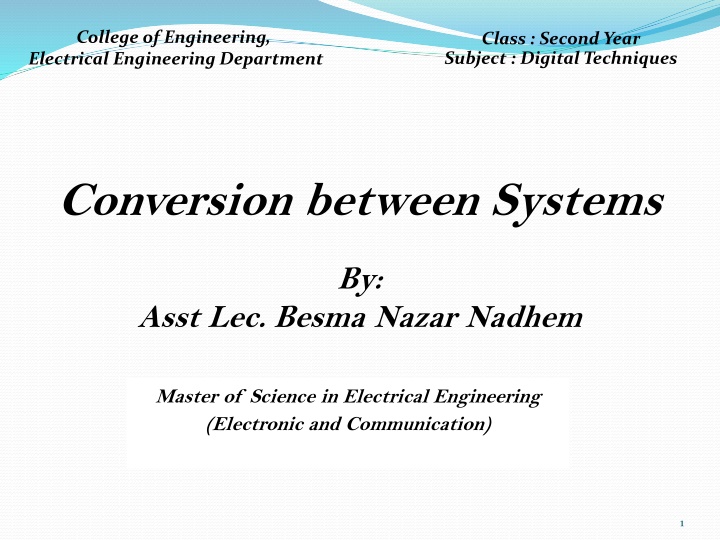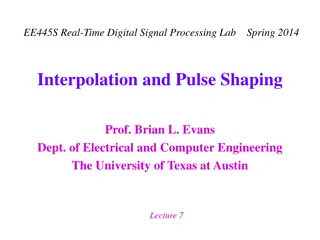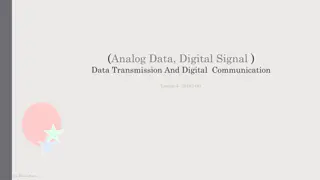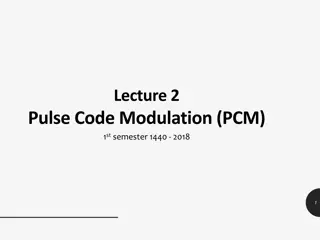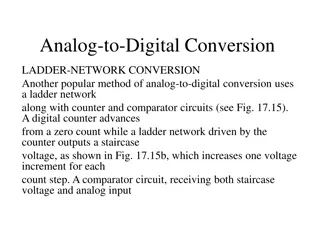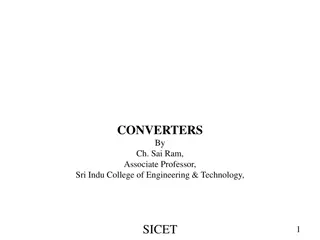Digital Techniques for Number System Conversion in Electrical Engineering
Understand how to convert between binary, octal, decimal, and hexadecimal number systems with examples and explanations. Learn the processes of binary-to-decimal, octal-to-decimal, hexadecimal-to-decimal, decimal-to-binary, decimal-to-octal, and decimal-to-hexadecimal conversions. Gain insights into the methods used in digital techniques for accurate system conversion.
Download Presentation

Please find below an Image/Link to download the presentation.
The content on the website is provided AS IS for your information and personal use only. It may not be sold, licensed, or shared on other websites without obtaining consent from the author.If you encounter any issues during the download, it is possible that the publisher has removed the file from their server.
You are allowed to download the files provided on this website for personal or commercial use, subject to the condition that they are used lawfully. All files are the property of their respective owners.
The content on the website is provided AS IS for your information and personal use only. It may not be sold, licensed, or shared on other websites without obtaining consent from the author.
E N D
Presentation Transcript
College of Engineering, Electrical Engineering Department Class : Second Year Subject : Digital Techniques Conversion between Systems By: Asst Lec. Besma Nazar Nadhem Master of Science in Electrical Engineering (Electronic and Communication) 1
Finding the Decimal Equivalent Binary-to-Decimal Conversion The decimal equivalent of the binary number (1001.0101)2 is determined as follows: The integer part = 1001 The decimal equivalent = 1 20+ 0 21 + 0 22 + 1 23 = 1 + 0 + 0 + 8 = 9 The fractional part = .0101 Therefore, the decimal equivalent = 0 2 1 + 1 2 2 + 0 2 3 + 1 2 4 = 0 + 0.25 + 0+ 0.0625 = 0.3125 Therefore, the decimal equivalent of (1001.0101)2 = 9.3125
Octal-to-Decimal Conversion The decimal equivalent of the octal number (137.21)8 is determined as follows: The integer part = 137 The decimal equivalent = 7 80+ 3 81 + 1 82= 7 + 24 + 64 = 95 The fractional part = .21 The decimal equivalent = 2 8 1 + 1 8 2 = 0.265 Therefore, the decimal equivalent of (137.21)8= (95.265)10
Hexadecimal-to-Decimal Conversion The decimal equivalent of the hexadecimal number (1E0.2A)16 is determined as follows: The integer part = 1E0 The decimal equivalent = 0 160+ 14 161 + 1 162 = 0 + 224 + 256 = 480 The fractional part = 2A The decimal equivalent = 2 16 1 + 10 16 2 = 0.164 Therefore, the decimal equivalent of (1E0.2A)16 = (480.164)10
Decimal-to-Binary Conversion Find the binary equivalent of (13.375)10. 13 6 3 1 2 2 2 2 LSP 1 0 1 1 0 MSP The fractional part = .375 0.375 2 = 0.75 with a carry of 0 0.75 2 = 0.5 with a carry of 1 0.5 2 = 0 with a carry of 1 The binary equivalent of (0.375)10 = (.011)2 Therefore, the binary equivalent of (13.375)10= (1101.011)2
Decimal-to-Octal Conversion Find the octal equivalent of (73.75)10 LSP 73 9 1 8 8 8 1 1 1 0 MSP The octal equivalent of (73)10= (111)8 The fractional part = 0.75 0.75 8 = 0 with a carry of 6 The octal equivalent of (0.75)10= (.6)8 Therefore, the octal equivalent of (73.75)10 = (111.6)8
Decimal-to-Hexadecimal Conversion Find the hexadecimal equivalent of(82.25)10 82 5 1 16 16 16 LSP 2 5 0 0 MSP The hexadecimal equivalent of (82)10 = (52)16 The fractional part = 0.25 0.25 16 = 0 with a carry of 4 Therefore, the hexadecimal equivalent of (82.25)10 =(52.4)16
BinaryOctal and OctalBinary Conversions An octal number can be converted into its binary equivalent by replacing each octal digit with its three-bit binary equivalent A binary number can be converted into an equivalent octal number by splitting the integer and fractional parts into groups of three bits, starting from the binary point on both sides. The 0s can be added to complete the outside groups if needed. Find the binary equivalent of (374.26)8 and the octal equivalent of (1110100.0100111)2 The given octal number = (374.26)8 The binary equivalent = (011 111 100.010 110)2= (011111100.010110)2 The given binary number = (1110100.0100111)2 (1110100.0100111)2 = (1 110 100.010 011 1)2= (001 110 100.010 011 100)2= (164.234)8
HexBinary and BinaryHex Conversions A hexadecimal number can be converted into its binary equivalent by replacing each hex digit with its four-bit binary equivalent. A given binary number can be converted into an equivalent hexadecimal number by splitting the integer and fractional parts into groups of four bits, starting from the binary point on both sides. The 0s can be added to complete the outside groups if needed. Find the binary equivalent of (17E.F6)16 and the hex equivalent of (1011001110.011011101)2. The given hex number = (17E.F6)16 The binary equivalent = (0001 0111 1110.1111 0110)2= (000101111110.11110110)2= (101111110.1111011)2 The given binary number = (1011001110.011011101)2 = (10 1100 1110.0110 1110 1)2 The hex equivalent = (0010 1100 1110.0110 1110 1000)2 = (2CE.6E8)16
HexOctal and OctalHex Conversions For hexadecimal octal conversion, the given hex number is firstly converted into its binary equivalent which is further converted into its octal equivalent. For octal hexadecimal conversion, the octal number may first be converted into an equivalent binary number and then the binary number transformed into its hex equivalent. Find the octal equivalent of (2F.C4)16 and the hex equivalent of (762.013)8 The given hex number = (2F.C4)16. The binary equivalent = (0010 1111.1100 0100)2= (00101111.11000100)2 = (101111.110001)2 = (101 111.110 001)2 = (57.61)8. The given octal number = (762.013)8. The octal number = (762.013)8 = (111 110 010.000 001 011)2 = (111110010.000001011)2 = (0001 1111 0010.0000 0101 1000)2 = (1F2.058)16.
